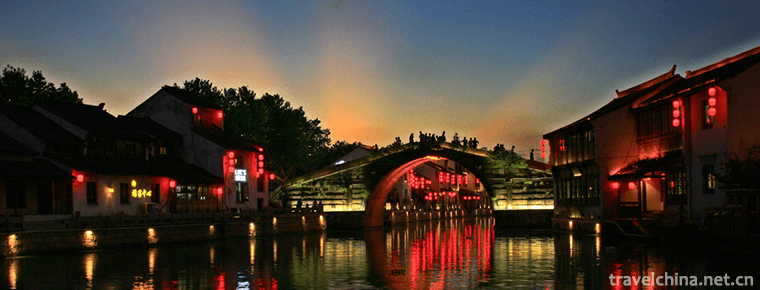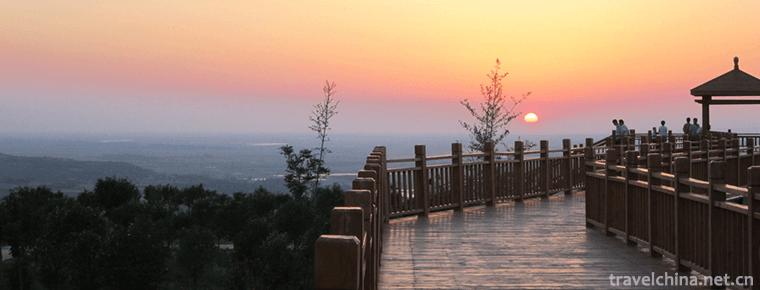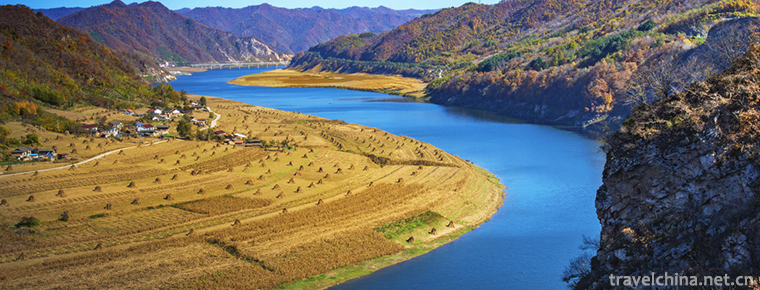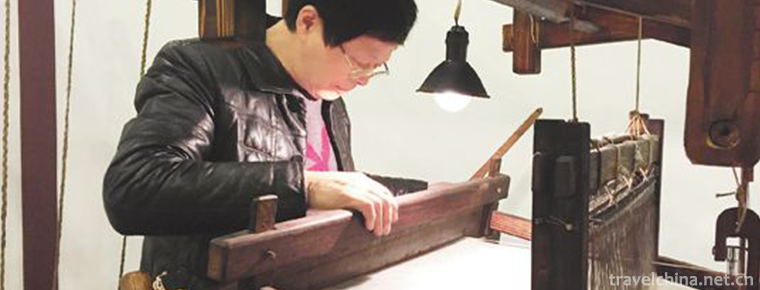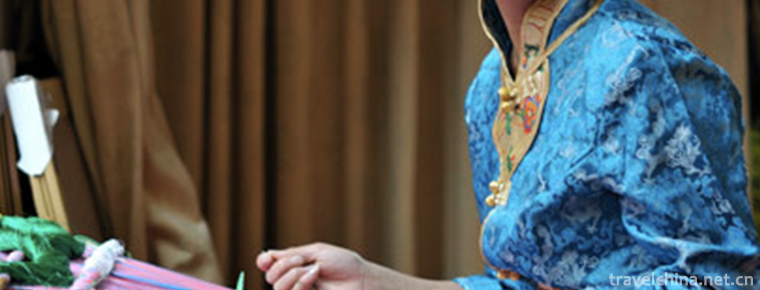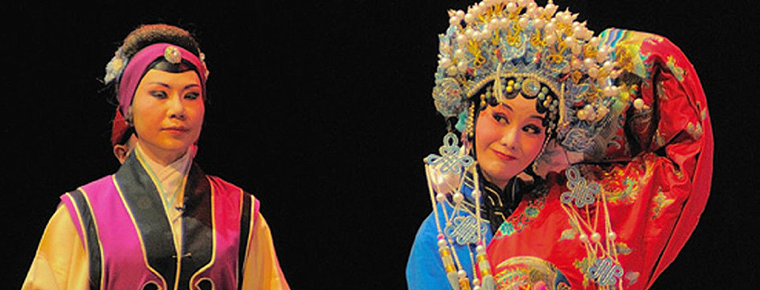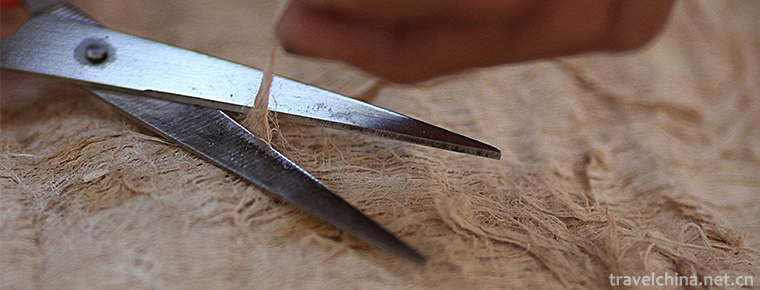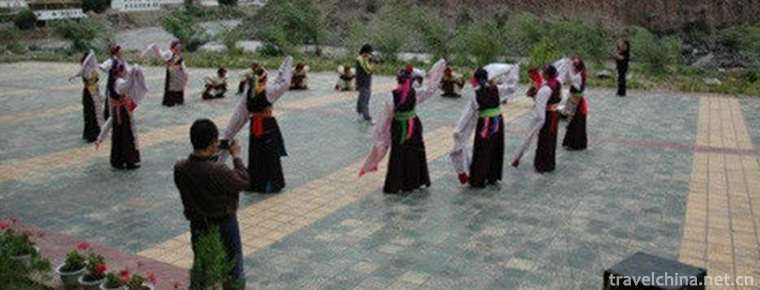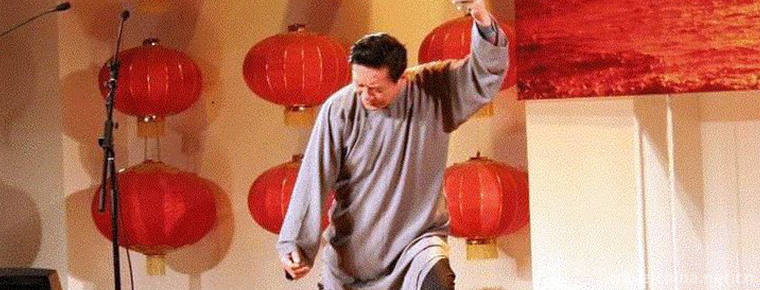Traditional drama
Traditional drama
Chinese drama mainly includes opera and drama, and opera is the traditional Chinese drama. After a long period of development and evolution, Baihua Garden of Chinese opera has gradually formed with the five major types of Chinese opera as the core, namely, Beijing Opera, Yueju Opera, Huangmei Opera, Commentary Opera and Henan Opera. Drama is a form of Western drama introduced in the 20th century. Chinese classical opera is an important part of the Chinese national culture, which can be called the quintessence of the country. With its artistic charm, it is popular among the people of all dynasties. Moreover, it also occupies a unique position in the world theatre, and is called the world's three ancient dramas together with the tragicomedy of ancient Greece and the Sanskrit of India.
Historical evolution
origin
The formation of opera can be traced back to the Qin and Han Dynasties at the earliest. However, the formation process was quite long, and it was not until the Song and Yuan Dynasties that it took shape. Mature operas should start from Yuan Zaju and enter modern times through the continuous development and maturity of Ming and Qing Dynasties. After more than 800 years of flourishing and unbeaten, there are now more than 360 kinds of operas. In the long process of development of Chinese classical opera, four basic forms of opera appeared successively: Southern Song-Yuan opera, Zaju of Yuan Dynasty, Legend of Ming and Qing Dynasty, local opera of Qing Dynasty and modern opera.
Southern opera in song and Yuan Dynasties
The Southern Opera of Song and Yuan Dynasty came into being in the late Northern Song Dynasty and the early Southern Song Dynasty. Wenzhou in Zhejiang Province and Quanzhou and Fuzhou in Fujian Province were the formative periods of the Opera. Southern Opera is an early and mature form of Chinese opera. It combines singing, dancing, reading, and Kofan to perform a complete story. Because the plot of the story is rather tortuous, the script is usually long, several times more than the Northern Opera. It uses southern tunes, rhythm and palace tunes are not strictly regulated. Its singing method is rich in changes, including solo, duet, rotation, chorus and so on. The main instrument is drum board. Because the tunes of Nanqu and Beiqu are different, their styles are quite different.
Qian Nanyang's Introduction to Opera and Literature has 238 kinds of Opera and Literature in Song and Yuan Dynasty, most of which are works of Yuan Dynasty, which is actually more than that. These operas are only written by Zhang Xiezhuangyuan (generally considered to be works of the Southern Song Dynasty), the mistaken position of the eunuchs, Xiaosun Tu, Pipa Ji, White Rabbit Ji, Jingchai Ji, Baiyue Pavilion, Dog Killing Ji and so on.
Zaju in Yuan Dynasty
Yuan Dynasty Zaju is also called Beiqu Zaju. Yuan Zaju originated in Zhending of Hebei Province and Pingyang of Shanxi Province in the late Jin Dynasty. Yuan Zaju was the first golden age of Chinese opera. It has reached a high literary level, so far as the style of poetry is concerned, the ancients have long called Tang poetry, Song Ci and Yuan Qu together.
Wang Guowei said, "The poetry of Tang Dynasty, the Ci of Song Dynasty and the Song of Yuan Dynasty are all so-called literature of a generation. "Yuan Zaju has achieved the lofty status of Tang poetry and Song poetry, and its outstanding achievements are mainly reflected in its profound ideological content and high artistic attainments.
Yuan Zaju has a wide range of themes, rich and profound content, and strong realistic and fighting spirit. In order to avoid cultural disasters, Yuan dramatists often use historical legends to reflect the reality. They directly draw on real life and often paint a protective color of "historical legends". However, many works vividly show the broad outlook of life in the Yuan Dynasty, which has a strong sense of the times and important practical significance:
1. To expose the darkness of society and reflect the suffering of the people. For example, Dou E's Injustice, Lu Zhai Lang, Chen Zhou Zhumi and so on, boldly attacked the autocratic rule and defeated politics of the Yuan Dynasty, so that people could see the dark social reality and the deep suffering of the people under the dual claws of the nation and class.
2. Expressing heroism and praising the people's resistance and struggle. Some praise the heroes of the people's uprising positively, such as "Double Dedication", "Li Ying Neijing" and so on. Some praise historical heroes, such as The Single Knife Club. Some show the resistance struggle of all kinds of weak figures, such as Dou'e's Injustice, the widow Dou'e's swearing at the government and damning the world; Chenzhou Dummy, the peasant Zhang Mingu's condemnation and rebellion against the powerful; Relief the Wind and Dust, the prostitute Zhao Paner Zhidouhua, who is too old.
3. Describing love and marriage, reflecting women's problems. Some depict the struggle of young men and women in sincere love and pursuit of marital autonomy, such as The Western Chamber, The Moon Pavilion, The Wall Head Immediately, Qian Nu's Soul Leaving, and the mythological drama Zhang Sheng Boiling the Sea and Liu Yi's Biography, which are known as the "Four Great Love Dramas", all share the same anti-feudal theme, showing women's aspirations and pursuits. Some reveal men's unjust ambitions and reflect women's unfortunate experiences, such as Xiaoxiang Night Rain and Qiuhu Opera Wife. Some reflect the tragic fate and life struggle of prostitutes, such as "Save the Wind and Dust" and "Golden Thread Pool".
4. Praise loyalty and lash out rape. For example, "Wu Tianta", "East Window Offender", "Zhao's Orphan" and so on, or embody national feelings, or eulogize justice. Many public drama exposed official corruption and praised some honest officials. Such works embody ideals, but also have a certain practical significance.
In terms of art, Yuan Zaju is novel and unique in form. It shows high attainments in structure, plot, characterization and drama language. It marks the maturity of Chinese opera art and has distinct artistic characteristics.
1. Realism is the mainstream of Yuan Zaju creation, but there are also many positive Romantic descriptions. While describing the suffering of the people, many excellent Zaju works also show the people's resistance and struggle, and often let them win; while for those arrogant and powerful, adulterers, they are given due punishment, so that they end up with failure, thus expressing people's ideals.
2. In terms of structure, most excellent miscellaneous dramatists can start from "filling in words for their debuts" and carefully set their eyes so as to concentrate the contradictions, highlight the main line, compact and changeable plots. Therefore, many miscellaneous dramas have strong dramatic effects.
3. Yuan Zaju has successfully created a large number of typical characters with distinct personality, which is an important symbol of its artistic maturity. Excellent writers such as Guan Hanqing, Wang Shifu, Kang Jinzhi and Ji Junxiang can arrange plots according to the inevitability of character development, and then reveal character characteristics through sharp and fierce dramatic conflicts, using various artistic means, so as to make the characters flesh and blood full and lifelike.
4. The language of Yuan Zaju is rich and colorful, and it has a strong expressive force. Yuan Zaju works absorb a large number of folk languages and integrate them with literary languages, forming the characteristics of popular, fluent, simple, straightforward and lively. This is a remarkable change in the development of Chinese literary creation from classical to vernacular. The language of most writers of Yuan Zaju emphasizes the essence, such as Guan Hanqing and Kang Jinzhi, while some writers, such as Wang Shifu and Ma Zhiyuan, attach more importance to literary grace.
Legend of Ming and Qing Dynasties
The legend of Ming and Qing Dynasties is a form of opera developed from Southern Opera in Song, Yuan and Yuan Dynasties. It originated in the late Yuan Dynasty, spread in the early Ming Dynasty, flourished in the Jiajing period of the Ming Dynasty, and flourished in Wanli, and extended to the late Ming and early Qing Dynasties.
Because of the general interest of all social strata in opera in Ming Dynasty, Kunshan and Yiyang tunes were popular in towns and villages. Royal palaces, noble and scholar-bureaucrat residences and folk temple fair grass-roots have frequent performances. The performance of the court in the Ming Dynasty was mainly performed by the "church hall" in the early stage, and in the Wanli period, the court set up "Four Zhais" and "Yuxi Palace" and other performing agencies. Sometimes they also call the city well theatre troupe to perform in the palace to adjust their performance. Noble and scholar-bureaucrat residences keep "family classes" privately, and some also perform their own scripts. In order to win the contest, they often explain and guide the actors themselves, rehearse carefully, put forward strict requirements for the actors in the performance, and reach a higher level in art, which has a certain role in promoting the development of the stage art of opera. Folk performances, there are land and water stage; theatre troupes have many skilled artists of Kun and Yizhu tunes. At this time, the performance of opera far surpasses the scale of Goulan Washe and Luqi Workshop in the Song and Yuan Dynasties.
In music, different tunes have different characteristics. For example, Kunshan Opera, a collection of North and South Opera, gives full play to the long flowing, euphemistic and delicate characteristics of South Opera, and suitably absorbs the passionate and generous style of North Opera. The collocation of all kinds of official tunes, the arrangement of venues, and more standardized, at the same time, the extensive use of the palace and the collection of songs, make the structure of the combination of tunes and cards more complete and expressive. Actors'singing skills are becoming more and more sophisticated, requiring "singing a variety of song titles and interests" to achieve a personalized and dramatic height. These are the long-term experience of dramatists and artists in Kunqu opera singing practice, and become an important heritage of Chinese national vocal music. The arrangement of accompaniment instruments and the organization of band scenes in Kunshan Opera are also more abundant and complete, enabling performances to be performed in the prescribed scenarios and rhythms, setting an example for the band accompaniment of later opera tunes and genres. The music of Yiyang's tunes is based on "more words and less sounds, and one pour out", creating "help tune" and "roll tune". "Bangqiang" is a vocal art that combines solo and chorus. To a certain extent, it makes up for the lack of accompaniment without musical instruments in Yiyang's various tunes. It also enriches the form of singing and plays the role of rendering characters'feelings and setting off the environment atmosphere. "Rolling tune" is a kind of "running water board", which is used to recite popular and easy-to-understand lyrics. It not only increases the change of music rhythm, but also helps to express the melody more smoothly. The vast majority of Yiyang tunes only use percussion instruments with strong sound effects such as gongs and drums as a backdrop, which is related to the conditions for performing for a large number of lower-class people in villages and towns, temples and squares. It is also closely related to the fact that the content of the previous works of Yiyang tune lays particular emphasis on historical dramas with numerous characters and lively scenes. Therefore, the overall style of Yiyang tunes appears to be high and unrestrained. These have a far-reaching impact on the music of later high-pitched operas.
In the performing arts, the fine division of roles is undoubtedly the key to enrich and improve the Performing Arts in this period. In particular, Kunshan Opera developed from seven roles in Nanxi Opera to twelve roles in Jianghu Opera, enabling actors to concentrate on the creation of certain types and characters, explore their hearts and figure out their personalities. Performing arts of all roles have their own unique play, and artists have created many distinct typical images. The "Eight Essentials of Stature" and "Ten Kinds of Art Diseases" put forward by "Liyuan Yuan" (Ming Xinjian), which summarizes the experience of Kunshan Opera performing arts, mark the strict requirements of Kunshan Opera performing arts. Although the performances of Yiyang tunes are not as delicate as Kunshan tunes, they also have achievements and styles that can not be ignored. Such as paying attention to the audience's acceptance ability in singing, making great efforts to use vivid recitation to activate the atmosphere of the stage, strengthening the dramatic and action of the performance, and avoiding the single Lyric in some traditional Southern dramas. According to the records of several entries in Qi Bingjia's Yuanshan Tang Qupin, the performers of Yiyang's various tunes also attach great importance to the inner portrayal of the characters, and often "can make the audience out of tears". Because of the need of historical drama performance, the war scenes displayed by folk martial arts and acrobatics are more unique in their fierce and rugged tones.
Local opera in Qing Dynasty
Local opera in Qing Dynasty is the third stage of classical opera. It shares the same artistic form with modern and contemporary operas. In the late Kangxi period of the Qing Dynasty, local operas flourished everywhere, known as the Flower Department. In the Qianlong period, they began to compete with Kunqu Opera called Yabu. By the end of the Qianlong period, the flower had overwhelmed the elegant part and occupied the dominant position on the stage until the end of the Daoguang period. These 150 years are the era of local operas in the Qing Dynasty. In 1840 and 1919, the opera was called modern opera, which included Tongzhi opera, Peking opera formed during Guangxu period and a period of opera improvement movement in the early 20th century. ,
Local operas in the Qing Dynasty had a strong and sad main style, which created a music system dominated by plate-style changes and a new literary form of drama. In addition, the structural form of drama text has changed from legendary separation to field separation, so that the style is no longer as cumbersome and loose as legendary, but has the characteristics of rigorous structure and suitable for audience acceptance. However, the local operas in the Qing Dynasty also had some shortcomings, such as miscellaneous language and low accuracy.
The number of local operas in Qing Dynasty is the largest in history. Historical materials: In 1956, when the first National Opera repertoire was counted, there were 51,867 traditional opera repertoires, which belonged to the local opera of the Qing Dynasty and had tens of thousands of scripts. Local operas in the Qing Dynasty were mostly created collectively by handicraftsmen from peasants or rural areas and artists at the bottom of urban society. Therefore, local operas in the Qing Dynasty had the characteristics of being close to the people and having a broad mass character. Local operas in the Qing Dynasty were mainly adapted from romances and novels of past dynasties. In addition, they are also adapted and transplanted in the form of zaju, legend, script and quyi. The themes of local operas in the Qing Dynasty can be divided into historical operas, women's operas, love and marriage operas, official case operas, mythological operas and humorous operas, as well as operas that can not be categorized. Among them, historical plays include "Ruyi hook", "Qinghe Bridge", "Yangping Pass". Women's plays include "Hua Mulan", "Fan Jiangguan". Love and marriage plays include "Buying Marriage Fat", "He Wenxiu" and so on. Official case plays include "Exploring Yin Mountain", "Qi Yuan Bao" and so on. Mythological plays include "People in Paintings", "Pipa Cave" and so on. Humorous small plays include "Changing the Old for the Young" and "Sacrificial Headscarf".
Modern Drama
Chinese drama was introduced into China from the West. From the beginning of the 20th century to the May 4th Movement, it was called "New Civilization Drama". This early drama still has some characteristics of opera. As an exotic art form, Civilized Drama must undergo a process of adaptation and adaptation if it is to be rooted in the cultural soil of the Chinese nation. In its early stage,'Art'must not only face the exclusiveness of local culture, but also seek certain support as the foothold of Chinese drama; however, it also prevents the melting of national culture and the loss of its independent character. Therefore, in the fierce collision between Chinese and Western cultures, the form of Civilized Drama has become a kind of "neither Chinese nor Western, neither new nor old, neither new nor old, mixed and mixed transition form". It is not like Western Drama in artistic form, but also mixed with the performance of opera; in content, it is often a mixture of Chinese and Western, lacking of its own things. At the same time, it has not found its own cultural orientation. Although it had flourished for a while, it was like a duckweed floating on the water, which had not yet taken root. After the May 4th Movement, Western drama was introduced again as it was, in the form of realist drama, known as "new drama". Since 1928, it has been called "drama" and has been used up to now.
In 1919, a May 4th Movement shocked China. It was a patriotic movement and a new cultural movement aimed at emancipating the mind. It advocates the banner of popular books and science, opposes the old morality and raises new morality: opposes classical Chinese and advocates vernacular Chinese; hence the rise of new literature, and new drama, namely shop drama, has also formed in this great cultural movement.
Western drama, after the transition of the stage of civilized drama in China and the cultivation of the May 4th New Culture Movement, has finally gained a firm foothold in China. Its symbols are: the emergence of new theatrical literature, a team engaged in drama, a special theatrical education, the rise of amateur theatre system, the active amateur (including campus) theatre troupe, the preliminary establishment of theatre director system, etc.
Wang Youyou was the first to put forward the idea of "love of beauty drama". He argues that the involvement of commercial forces makes theatre one-sided emphasis on profit, thus undermining art. Therefore, he would like to imitate the Western "Amateur" and the Western "vegetarian theatre" approach to organize a non-operating theatre group. This idea was realized in the second year after the May 4th Movement. On his initiative, the Shanghai People's Theatre Society was founded and became the first drama group after the May 4th Movement. Its founding "Declaration" said: "When theatre is a leisure time, the era is now over, theatres in modern society really occupy an important position, is the wheel to promote social progress, but also to search for the root causes of social illness X-ray mirror."
Since then, Peking University, Tsinghua University, Yanjing University, Nankai University and some middle schools have also launched the "beauty-loving drama" campaign. Campus theatre troupes have sprung up, forming a scenic line of "May 4th" drama.
After the decline of the Popular Theatre society, another theatre group in Shanghai, the Drama Association, emerged. In the 1920s, it not only organized many public performances and performed a number of famous plays, but also stirred up Shanghai with a "Fan of Little Grandma", which made the drama famous. In addition, it first established a modern director system in Chinese drama circles, and trained a lot of drama talents. The reason for its success is related to Hong Shenzhi, a famous dramatist.
During the May 4th New Culture Movement, traditional opera was severely criticized, and then it entered the modern opera era. The formation of Peking Opera was the result of the development of local operas in the Qing Dynasty, and Peking Opera did not depress the development of local operas after it became a national representative opera. From local opera in Qing Dynasty to Peking opera, Chinese opera is extremely prosperous.
At the beginning of the 20th century, along with the vigorous ideological trend of change in the field of Chinese culture, the dramatic improvement movement was also vigorously launched. But at that time, the new plays, namely "Civilization Drama" and early drama, were not set up by directors. In 1921, when Hong Shen, a dramatist, returned from studying in the United States, he and his colleagues in the performance and practice of the Shanghai Drama Association established a formal director rehearsal system, and formulated and formed a more complete director system. But it was after the 1930s that the art of theatrical director really developed. At the beginning of the 20th century, Shanghai Peking Opera artists drew lessons from the early stage performances. In 1925, Zhou Xinfang first used the words of director in the advertisement when he performed Han Liu Bang: "Zhou Xinfang, the editor-director of the monarch, directed two great dramas in the history of Han Dynasty. In 1930, Mei Lanfang went to the United States to perform and hired Nankai University professor Zhang Pengchun, who was lecturing in the United States, to help sort out and revise the play." Zhang Pengchun also used the term "director" at that time, but the establishment and formation of the director system in Peking Opera was after the founding of the People's Republic of China, and the real introduction of the director system into the field of opera, and the establishment of the director system in opera, was the reform of Yuen Xuefen's Yue Opera in the 1940s.
In the 1930s, China's history was full of hardships. On the one hand, the intensification of national contradictions, the outbreak of the "B. 18" Incident in 1931, the Japanese army's invasion of the iron hoof trampled on the northeastern region of China; on the other hand, the intensification of class contradictions, the masses of workers and peasants against capitalists and homestead struggle surging.
During this period, Chinese drama continued to absorb and draw lessons from Western drama, but it has shifted from mergers and acquisitions of various schools to emphasis on realism, and the experimentation of modernist drama has gradually disappeared. Under the impetus of the times, Chinese drama swept away the past romantic and sentimental foundation, turned to grief and resistance, and took the initiative to arouse the people and save the country. After more than ten years of exploration, Chinese drama has finally found its own way of development and started to mature. Its main features are as follows: closely combining drama with the needs of Chinese society and the people, rooted in the soil of national culture, while drawing lessons from western drama, and using the traditional Chinese artistic spirit, it creatively transforms this foreign artistic form into a kind of drama that is needed by Chinese reality and loved by the Chinese people; A number of outstanding playwrights and dramas, such as Xia Yan, began to appear, and the Performing Arts approached and reached the world level.
Opera has always been rooted in the Chinese people and is popular with the people. There are many kinds of Chinese operas. According to incomplete statistics, there are more than 360 kinds of local operas and tens of thousands of traditional operas in various ethnic areas of China. Among them, Beijing opera, Yueju opera, Huangmei opera, commentary opera and Henan opera are called the five major types of Chinese operas in turn. Various local operas have their own audiences. People who are far away from their homeland even think of listening to and watching national operas as a way to miss their homeland.
Apart from drama, there are about 360 kinds of operas in various ethnic areas of China, and there are tens of thousands of traditional operas. Since the founding of the People's Republic of China, many traditional dramas have been adapted. New historical dramas and modern dramas with modern life themes have been warmly welcomed by the audience.
Artistic characteristics
Comprehensiveness
In drama, literature, art, dance, music, and even architectural art can all become part of drama art. Therefore, drama art must follow the creative rules of many art categories which are extremely complex and mutually restrictive, and it itself has many aesthetic values. At the same time, drama, as a comprehensive art, is not a simple combination of various artistic elements. The comprehensive nature of drama requires that its various artistic elements must be subordinated to the overall aesthetic principles of drama, and can be organically combined with each other to present the audience with the overall stage image. On this basis, drama can form its unique aesthetic value.
Stage intuition
The drama must be performed by the actors, face the audience on the stage, and complete the performance with a complete plot and full of fierce contradictions and conflicts. Therefore, it requires actors to be angry, attentive and sincere. Through individualized and action-oriented language, action and expression, we can create vivid and vivid visual images for the audience. At the same time, we also need to limit the activities of the characters to a certain stage space and a certain performance time, to show the broadest possible content of life in a limited stage space and time, and to give the audience aesthetic impression.
Contradiction and Conflict
There is no drama without conflict, and fierce conflict plays an important role in drama art. As far as the content of drama is concerned, almost all excellent dramas at all times, at all times and in all over the world show intense conflicts or inner contradictions between the characters in action. As far as the form of drama is concerned, because of the limitation of stage, it must put aside all minor events and show the most fundamental conflicts between the characters, characters and the environment in order to pass through intense conflicts. The dramatic contradictions attract the audience.
As a unified whole, theatrical art can be divided into two basic elements which restrict and differ from each other: stage art and theatrical literature. Stage art includes performance, stage art, lighting, setting, sound effects and other factors. Among them, actors'performances are the center of the whole stage art. As for actors' performances, there have been two major schools in the history of modern drama: "expressionism" and "experientialism". "Expressionism" emphasizes the actors'calm observation of life and creates "ideal model" in rehearsal. When performing, we must strictly follow all the rules in the "model", "experiential school" emphasizes on truthfully reflecting the inner world and spiritual outlook of the characters, advocating that every performance should enter the role and make a living direct experience. It should be admitted that both factions have reasonable elements. The controversy between "expressionism" and "experientialism" deeply reflects the differences in the principles of artistic creation.




-
Chinese Shared bicycle
Shared bicycle refers to the bicycle sharing service provided by enterprises in campus, subway station, bus station, residential area,.
Views: 183 Time 2018-11-13 -
Qingming Bridge Ancient Canal Scenic Area
Qingming Bridge Ancient Canal Scenic Area is located at the southern end of Wuxi city center, covering about 44 hectares of scenic area. The scenic spot is composed.
Views: 161 Time 2019-02-07 -
Tongguan Yellow River Scenic Area
Tongguan Yellow River Scenic Spot is located at the famous ancient military pass-Tongguan ancient city, 140 kilometers away from Xi'an, only 20 kilometers away from Huashan.
Views: 80 Time 2019-02-22 -
Yalu River Scenic Spot
Yalu River Scenic Spot is located in Dandong City in the middle and lower reaches of Yalu River. It is 210 kilometers long from Hunjiang Estuary in the East and from Dadong Port in the west.
Views: 203 Time 2019-02-27 -
Silk Weaving Techniques
Silk weaving is a traditional Chinese handicraft with a long history. It consists of four parts: Yuhang Qingshui silk sponge production technology, Hangluo weaving technology.
Views: 166 Time 2019-04-04 -
Tibetan knitting and embroidery
Tibetans are good at embroidery and textile, and exquisite craftsmanship adds infinite charm to their costumes, which is the most prominent manifestation of Tibetan.
Views: 136 Time 2019-04-05 -
Tibetan Gugu Encouragement
Tibetan God inspiration has a long history. As for its origin, there is a legend that one or two hundred years ago, a "Gawa Hubo" (i.e. a local official) in Ningba village danced in the mans.
Views: 390 Time 2019-04-05 -
Chu opera
Chu Opera, a local traditional drama in Hubei Province, is one of the national intangible cultural heritage..
Views: 194 Time 2019-04-18 -
Production Techniques of Bark Cloth of Li Nationality
Li bark cloth production technology is based on the bark of plants as raw materials, after beating technology to produce cloth technology..
Views: 90 Time 2019-05-12 -
Mangkang Trichord Dance
Sanxian Dance originated in Quzika Township, Mangkang County, Changdu District. It has the unique charm of simplicity, elegance, melodiousness and ease, and is deeply loved by the masses. Passengers p.
Views: 210 Time 2019-05-22 -
Shandong Express Book
Shandong Quick Book, originating from Shandong Province's local traditional folk art form, has a history of more than 100 years. It was first popular in Shandong, North China and Northeast China, and .
Views: 168 Time 2019-06-13 -
Mineral resources in Dazhou
As of 2012, 38 kinds of minerals have been found in Dazhou City, with more than 250 producing areas. Among them, there are 28 proven reserves, 146 producing areas, 28 exploitable and 21 developed. The proven reserves of stone coal are 763 million.
Views: 134 Time 2020-12-20

